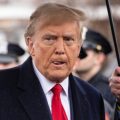U.S. Treasury yields experienced a significant jump on Wednesday, April 9th, 2025, as the market continued to react to President Trump’s controversial tariff policies. The 10-year Treasury yield surged by 10 basis points, reaching 4.363%, while the 2-year yield climbed 7 basis points to 3.808%. This dramatic increase reflects investor anxiety surrounding the escalating trade tensions. One basis point, it’s worth remembering, equals 0.01%, and yields move inversely to prices. This means the value of existing Treasury bonds declined as yields rose.
The immediate trigger for this market volatility stems from the implementation of President Trump’s reciprocal tariffs on imports from over 180 countries. These tariffs, imposed last week, officially began impacting imports from 86 nations on Wednesday. The situation has intensified into a full-blown trade war, particularly between the US and China, with a combined tariff rate of 104% now impacting Chinese imports. China retaliated with tariffs of its own, further escalating the conflict. Adding fuel to the fire, Canada responded with 25% tariffs on US-made vehicles, citing non-compliance with the USMCA (United States-Mexico-Canada Agreement).
The market is anxiously awaiting the release of key economic indicators. The Consumer Price Index (CPI) is due out on Thursday, and the Producer Price Index (PPI) on Friday. These reports will provide crucial insights into the overall health of the US economy and could further influence Treasury yields. Concerns are also growing after Tuesday’s auction of 3-year Treasury notes revealed weaker-than-expected demand, signaling potential market instability.
Henry Allen, vice president and macro-strategist at Deutsche Bank, expressed significant alarm in a recent note. He highlighted the aggressive selloff in U.S. Treasury markets, questioning their traditional safe-haven status. The severity of this selloff is prompting speculation that the Federal Reserve might intervene with an emergency interest rate cut to stabilize market conditions. Market pricing in fed funds futures already suggests a growing likelihood of such a move, reminiscent of responses during the COVID-19 crisis and the 2008 financial crisis.
The situation remains highly fluid, with investors closely monitoring the unfolding trade war and its potential long-term effects on the global economy. The upcoming release of economic data will undoubtedly play a significant role in shaping market sentiment in the coming days.










